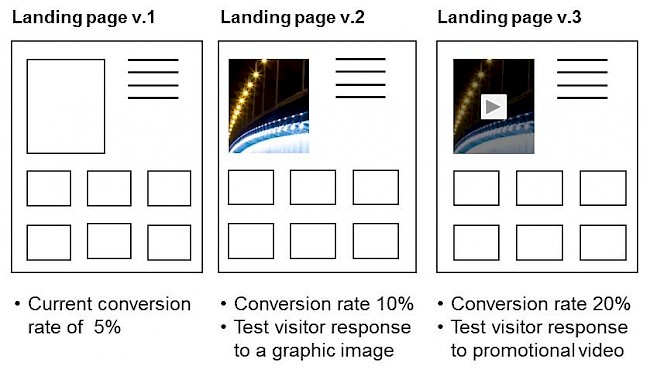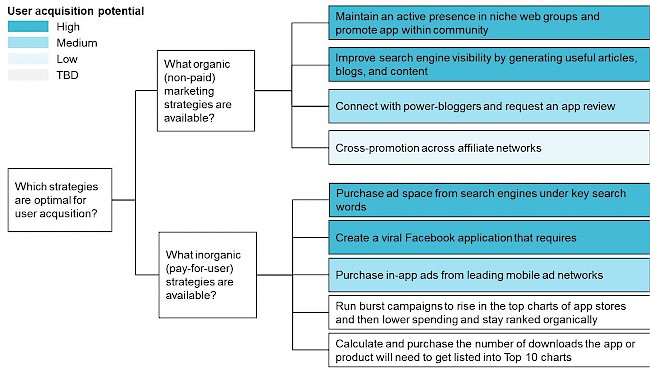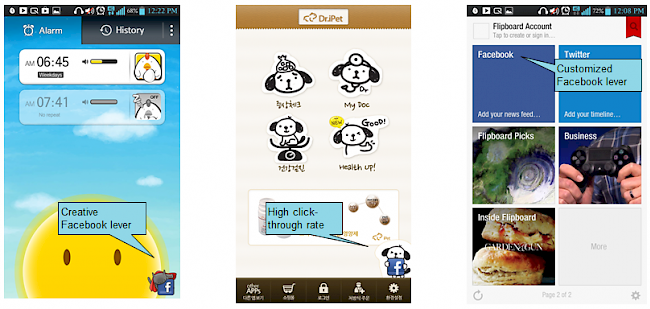Boosting the discovery of a mobile application by fully leveraging digital marketing and social media
22 March 2013 — The explosive growth of app platforms has turned app discovery into the number one challenge for marketers and developers alike. This article describes how to boost the discovery of your mobile app through digital marketing and social media.

Download this post (PDF)
The explosive growth of app platforms has turned app discovery into the number one challenge for marketers and developers alike. With Google Play and Apple App store each now reporting over 700 000 listed apps, it is getting extremely difficult to attract users to an app. In fact, app stores are becoming similar to the general web in their growing complexity of search and discovery. A single app listing in a market of thousands will not be enough to significantly boost user acquisition rates. This article describes how to boost the discovery of your mobile app through digital marketing and social media.
A digital marketing architecture for organic app discovery
Most developers understand digital marketing to the extent of placing banner ads on websites and optimizing content for search engine crawls. This often leads to a fragmented marketing effort with poor coordination and short-term wins only. In order to maximize user acquisition rates for the long-term, an integrated marketing engine must be set in place. It should coordinate rich and relevant content across the user’s entire experience with the app, from initial search to actual download and referral to friends. Through our extensive work with app startups in South Korea, we have found out that the model presented in Exhibit 1 produces very good results for app discovery.
Exhibit 1: The app discovery model
The model is built for mobile app startups but the technique and logic is applicable to most online businesses. General web traffic is first built through a combination of organic (free) and inorganic (paid) tactics—with a focus on rich content generation in niche web communities. This stream of web traffic is brought to a landing page to test conversion of casual visitors to actual app users. Elements on the landing page are then tested to measure their effectiveness in promoting visitors to click the download button. Web analytics tools are also placed on the landing page to extract data on web traffic demographics and referral sources. Marketing resources are then focused on web sources which provide the highest number of targeted users at the lowest cost. Users are incentivized to engage with the corporate Facebook page to open a two-way flow of communication. A corporate blog and other social media sites are also integrated with Facebook to promote brand loyalty and referral rates among users.
Focus on niche marketing for web traffic
The first stage involves testing multiple web sources for large streams of targeted web traffic. Ideal sources are websites, blogs, forums and other communities that match three criteria: high volume of web traffic at very low cost with a high conversion rate. Developers should aggregate potential sources into a short list and then consider both organic and inorganic methods as shown in Exhibit 2.
Exhibit 2: Tactics in boosting web traffic
Organic marketing is based on referrals and word-of-mouth recommendations. One success factor in organic marketing is finding niche web communities. Developers need to find blogs, websites, social media and news sources that their target user group interacts with on a regular basis. Sources which have a large number of users are not as useful as sources which have users that are highly active and interact within the source. Leveraging these communities requires uploading engaging informational content onto them that users can benefit from and placing a promotional link to direct traffic to the landing page.
Drive targeted web traffic to an optimized landing page
The landing page is optimized to drive a specific call-to-action from incoming web traffic. For apps that have already released, this action is to click the download button. (In the case that the app is still in development, the call-to-action could be filling out an e-mail form). Components of the landing page such as text, images or buttons should promote users into performing the action. The effectiveness of each component can be measured with an A/B test, as presented in Exhibit 3.
 Exhibit 3: A/B test of landing page
Exhibit 3: A/B test of landing page
Developers often ask why they should not simply direct general traffic to the app store directly. This is a great question as it seems like a round-about way in downloading the app. However, a landing page can serve as a data extractor for the inbound stream of web visitors. Google Analytics or other web analytics services provide insight into referral sources of the web traffic as well as the percentage of traffic that comes from each source. Developers can then compare the amount of web traffic generated from each source against the cost of advertising on that channel. A good rule of thumb is to apply Pareto’s principle (80% of output is generally produced from 20% of the inputs) and identify the few channels that are generating the larger portion of traffic. Focusing marketing resources on these specific channels should maximize the marketing ROI.
Utilize a creative lever to migrate users from the mobile app to Facebook
After the users have downloaded the app and experienced the product, it is critical to extend the engagement with them on Facebook. It is difficult for users to provide feedback or share app content with friends from within the app itself. A crafty way to migrate app users to the app’s Facebook page is to insert a creative in-app Facebook lever. Curiosity often entices users to click through this lever (Exhibit 4). If adding elements to the user interface is not optimal, the action of liking” the Facebook page can be incentivized through in-app rewards such as currency or points.
Exhibit 4: Creative in-app Facebook levers, by courtesy of Alarm Mon and Ipet Brand
Leveraging Facebook as a primary marketing platform for building brand loyalty
Mobile users engage with an app for a specific purpose and the duration of the engagement is often limited to a few minutes per day or week. Thus it is very difficult for developers to build brand equity and loyalty through just the app itself. On the other hand, users around the world spend countless hours browsing aimlessly on social media sites like Facebook. Developers can leverage this as an opportunity for brands to engage users through content and deepen their bonds with users outside of the app.
Building up a large Facebook fan base provides app developers with a platform for quick market tests. From development features to marketing ideas, it enables getting immediate feedback directly from the users. Developers can also leverage their app’s Facebook page as a tool for monetization as well as crowdsourcing. They can for example organize a “flash sale” to sell merchandise or challenge fans to help find an answer to a problem. As the Facebook fan base grows larger and engagement increases, it is possible to develop a strong group of brand advocates that will help amplify the reach of the app.
The initial inflow of Facebook fans will come from the in-app Facebook lever. This lever should be complemented with “promoted posts” to continue building up the fan base. Promoting a post enables the post to be displayed to a specified target audience outside of the current fans. It is a best practice to promote posts with an info-graphic image. Web users respond well to informative content that is packaged in a visually appealing manner. It is also a good idea to periodically change the design of the in-app Facebook lever. Some developers have even created Facebook apps that require users to like the Facebook page in order to amass a large amount of fans in a short period.
Integrate a corporate blog and other social media services with Facebook
Facebook should be integrated with other social media channels to benefit from cross-promotion and referral traffic. The content of the Facebook campaign and its fit on other social media sites should be analyzed to enable this. For example, if an app is related to fashion and its Facebook fans respond very well to clippings of designer clothes, content could be shared from Pinterest, a service which allows members to “pin” images to their pinboard. If an app is educational, material could be published and shared on video publishing sites such as Youtube or Vimeo. If an app involves social sharing, leveraging the large community of Instagram, a photo-sharing service that enables users to take pictures could be beneficial. It is important to search for complementary social media platforms that fit the target user base.
An official corporate blog should also be integrated into the social media mix for increasing search engine visibility. A Google search of an app will most likely return a single listing in Google Play or App Store. Content uploaded in social media sites like Facebook aggregate under a single listing and do not provide optimal search listing results. On the other hand, blogs provide an easy platform for search engines to crawl for content and keywords. Blogging helps to increase the app’s search listings and improves app discovery on the web.
***
App discovery will remain a core issue as many developers continue to build their app with the “build it and they will come” mentality. An app, at the end of the day, is a software product and it will not distribute itself. Social media will remain at the forefront of app discovery as word-of-mouth recommendations have been the primary driver behind past successful viral apps. Entrepreneurs must leverage every marketing platform they own and coordinate content across channels to make sure that potential users know about their mobile apps.













